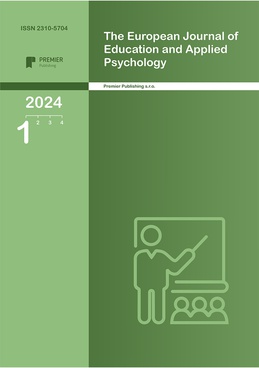Evaluation of Coordination Abilities of the Upper and Lower Limbs and Explosive Power in Children aged 9 – 10 years
Authors
Keida Ushtelenca

Share
Annotation
Strength and muscle power are essential for human performance and for maintaining bone health at every age. If body mass is the optimal load for maximal power production in weight-bearing activities, then generation of force, motor control, and movement velocity are task-dependent. The main objectives of this study were to evaluate the coordination of the upper and lower limbs and explosive power of 9 - 10-year-old children, and compare results between boys and girls. A total of 309 subjects (boys n=164, and girls n=145) were randomly selected from four 9-year schools in the city of Tirana. All were fourth grade students. The ROLi test was used to evaluate coordination skills of the upper limbs, while to evaluate coordination of the lower limbs, ROLu test was used. Standing Long Jump (Eurofit 1993) was employed to evaluate the explosive power of the legs.
Keywords
Authors
Keida Ushtelenca

Share
References:
Behm, D. G., Faigenbaum, A. D., Falk, B., & Klentrou, P. (2008). Canadian Society for Exercise Physiology position paper: resistance training in children and adolescents. Applied Physiology, Nutrition, and Metabolism, 33(3), 547–561. https://doi.org/10.1139/h08-020
Catley, M. J., & Tomkinson, G. R. (2011b). Normative health-related fitness values for children: analysis of 85347 test results on 9–17-year-old Australians since 1985. British Journal of Sports Medicine, 47(2), 98–108. https://doi.org/10.1136/bjsports-2011-090218
Cormie, P., McGuigan, M. R., & Newton, R. U. (2011). Developing maximal neuromuscular power. Sports Medicine, 41(2), 125–146. https://doi.org/10.2165/11538500-000000000-00000
Janz, K. F., Dawson, J. D., & Mahoney, L. T. (2002). Increases in physical fitness during childhood improve cardiovascular health during adolescence: the Muscatine study. International Journal of Sports Medicine, 23(S1), 15–21. https://doi.org/10.1055/s-2002-28456
Jarić, S., & Marković, G. (2009). Leg muscles design. Medicine and Science in Sports and Exercise, 41(4), 780–787. https://doi.org/10.1249/mss.0b013e31818f2bfa
Kemper, H., De Vente, W., Van Mechelen, W., & Twisk, J. W. R. (2001). Adolescent motor skill and performance: Is physical activity in adolescence related to adult physical fitness? American Journal of Human Biology, 13(2), 180–189. https://doi.org/10.1002/1520-6300(200102/03)13:2
Kraemer, W. J., & Fleck, S. J. (1992). Strength training for young athletes. http://ci.nii.ac.jp/ncid/BA20847889
Martin, R. J. F., Doré, É., Twisk, J. W. R., Van Praagh, E., Hautier, C., & Boccadoro, M. (2004). Longitudinal Changes of Maximal Short-Term Peak Power in Girls and Boys during Growth. Medicine and Science in Sports and Exercise, 36(3), 498–503. https://doi.org/10.1249/01.mss.0000117162.20314.6b
Mikkelsson, L. (2006). Adolescent flexibility, endurance strength, and physical activity as predictors of adult tension neck, low back pain, and knee injury: a 25 year follow up study. British Journal of Sports Medicine, 40(2), 107–113. https://doi.org/10.1136/bjsm.2004.017350
Rønnestad, B. R., Kojedal, Ø., Losnegard, T., Kvamme, B., & Raastad, T. (2011). Effect of heavy strength training on muscle thickness, strength, jump performance, and endurance performance in well-trained Nordic Combined athletes. European Journal of Applied Physiology, 112(6), 2341–2352. https://doi.org/10.1007/s00421-011-2204-9
Ruiz, J. R., Castro‐Piñero, J., Artero, E. G., Ortega, F. B., Sjöstróm, M., Suni, J., & Castillo, M. J. (2009b). Predictive validity of health-related fitness in youth: a systematic review. British Journal of Sports Medicine, 43(12), 909–923. https://doi.org/10.1136/bjsm.2008.056499
Sauka, M., Priedite, I. S., Artjuhova, L., Lāriņš, V., Selga, G., Dahlström, Ö., & Timpka, T. (2010b). Physical fitness in northern European youth: Reference values from the Latvian Physical Health in Youth Study. Scandinavian Journal of Public Health, 39(1), 35–43. https://doi.org/10.1177/1403494810380298
Strong, W. B., Malina, R. M., Blimkie, C. J., Daniels, S. R., Dishman, R. K., Gutin, B., Hergenroeder, A. C., Must, A., Nixon, P. A., Pivarnik, J. M., Rowland, T. W., Trost, S. G., & Trudeau, F. (2005). Evidence based physical activity for school-age youth. The Journal of Pediatrics, 146(6), 732–737. https://doi.org/10.1016/j.jpeds.2005.01.055
Taipale, R. S., Mikkola, J., Vesterinen, V., Nummela, A., & Häkkinen, K. (2012). Neuromuscular adaptations during combined strength and endurance training in endurance runners: maximal versus explosive strength training or a mix of both. European Journal of Applied Physiology, 113(2), 325–335. https://doi.org/10.1007/s00421-012-2440-7
Twisk, J. W. R., Kemper, H., & Van Mechelen, W. (2000). Tracking of activity and fitness and the relationship with cardiovascular disease risk factors. Med Sci Sports Exerc, 32(8), 1455–1461. https://doi.org/10.1097/00005768-200008000-00014
Vicente-Rodríguez, G., Jimenez-Ramirez, J., Ara, I., Serrano-Sánchez, J. A., Dorado, C., & Calbet, J. a. L. (2003b). Enhanced bone mass and physical fitness in prepubescent footballers. Bone, 33(5), 853–859. https://doi.org/10.1016/j.bone.2003.08.003
Wilson, G. S., & Murphy, A. B. (1996). The use of isometric tests of muscular function in athletic assessment. Sports Medicine, 22(1), 19–37. https://doi.org/10.2165/00007256-199622010-00003


